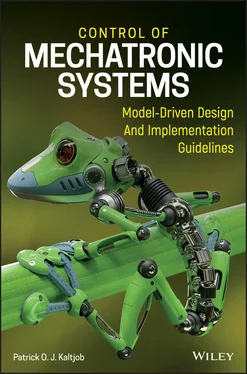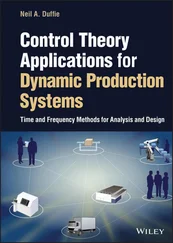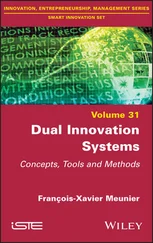D 1Karnaugh table.Table 6.26
D 0Karnaugh table.Table 6.27
Open output Karnaugh table.Table 6.28 State transition table with a D-flip-flop gate.Table 6.29 Truth table when two out of three detectors are checked.Table 6.30 Truth table when using a virtual disagreement detector.Table 6.31 Truth table of process outputs.Table 6.32 K-maps of a motor starter system.Table 6.33 Truth table of a belt fastening process.Table 6.34 Truth table of outputs
LAMP 1,
LAMP 2, and
LAMP 3.Table 6.35 K-maps of a starter motor system.Table 6.36 Equipment involved in an electric driverless car motion control sy...Table 6.37 Sequence table of the laser-based cutting process.Table 6.38 I/O interface addresses for a car engine safety program.Table 6.39 Sequence state table for a car engine starter.Table 6.40 Some input and output variables involved in an automated drug cond...
7 Chapter 7Table 7.1 Commonly used variables for monitoring software design.Table 7.2 Listing of typical FAST expected results.Table 7.3 Process equipment listing.Table 7.4 System performance audit and specifications of the cement-drying pr...Table 7.5 Start and stop operating mode of cement-drying process.Table 7.6 Process equipment listing.Table 7.7 Process equipment listing.Table 7.8 Process operating modes and sequences.Table 7.9 Pasteurization process operating sequence.Table 7.10 Fermentation process operating sequence.
8 Chapter 8Table 8.1 Typical electrical-driven actuating systems.Table 8.2 Control variables and system parameters of a DC motor.Table 8.3 Coil location per number of stator phases.Table 8.4 Dynamical equations for the motion and torque of some mechanical tr...Table 8.5 Parameters and variables used.Table 8.6 Dynamics equations governing heat transfer.Table 8.7 Typical variables and associated sensing methods.Table 8.8 Some commonly encountered sensors.Table 8.9 Distance formula using a TOF technique.Table 8.10 Example LMP sensor characteristics.Table 8.11 Example of binary codes generated by absolute rotary encoder.Table 8.12 RFID signal properties and characteristics.
9 Appendix ATable A.1 Typical model structure encountered for a system model.Table A.2 Commonly used statistical criteria for model order validation.
10 Appendix BTable B.1 Generic step response model types and corresponding transfer functi...
11 Appendix C Table C.1 Z -transform table.Table C.2 Delay-included z -transform table.
1 Chapter 1 Figure 1.1 Customized 3D food printer. Figure 1.2 Steam-based power generation technical process schematic. Figure 1.3 Generic controlled mechatronic systems and instrumentation block ... Figure 1.4 Relationship between technical process and machine control system... Figure 1.5 Generic control systems and instrumentation block diagram. Figure 1.6 Image-guided tele-assisted robot intravascular surgery. Figure 1.7 (a) Chassis of a driverless vehicle. Source: Based on Kaltjob P. ... Figure 1.8 Crane-based vertical motion control system schematic. Figure 1.9 (a) Block diagram of the crane motion feedback control system. (b... Figure 1.10 Milk-based beverage processing factory schematic. Figure 1.11 Block diagram with SCADA components for a milk-based beverage pr... Figure 1.12 Generic controller design steps and dependencies. Figure 1.13 Overview of activities related to control project management.... Figure 1.14 Egg incubator schematic. Figure 1.15 Dialysis blood processing system. Figure 1.16 Guided missile trajectory. Figure 1.17 Schematic of a crude oil distillation process with its boiler te... Figure 1.18 Cake conveyor oven. Figure 1.19 Helicopter schematic. Figure 1.20 Electric-driven car moving up the hill. Figure 1.21 Automatic fruit harvesting robot. Figure 1.22 Schematic of nuclear plant. Figure 1.23 Incomplete block diagram of a nuclear plant continuous control s...
2 Chapter 2 Figure 2.1 (a) Schematic of the sea port gantry crane and its components. (b... Figure 2.2 Typical variation of swaying angle and spreader speed over time.... Figure 2.3 Classical elevator system schematic and its components. Figure 2.4 Parallel configuration of a hybrid electric vehicle. Figure 2.5 Vehicle forces schematic. Figure 2.6 Schematic of a Segway transportation system. Figure 2.7 Neonatal incubator and its typical components.Figure 2.8 Glucose-insulin metabolism under a model prediction control parad...Figure 2.9 Mixing tank system.Figure 2.10 Water treatment and distribution process schematic.Figure 2.11 Cake conveyor-oven system.Figure 2.12 Poultry processing system with ammoniac flow.Figure 2.13 Distillation tower schematic.Figure 2.14 Distillation tower.Figure 2.15 Fermentation tank schematic.Figure 2.16 Drilling machine system.Figure 2.17 (a) Pozzolana portal scraper schematic and components. Source: A...Figure 2.18 Subprocess function block diagrams for the pozzolana portal scra...Figure 2.19 Wind turbine generator system.Figure 2.20 Inclined elevator schematic and its components.Figure 2.21 Furnace-based crude oil heating system.Figure 2.22 Crude oil preheating and distillation.Figure 2.23 Schematic of laser-based surgery on human tissue.Figure 2.24 Equivalent workpiece cutting process with the clamping system.Figure 2.25 Cross-sectional view of the cutting process with a machine tool....Figure 2.26 Detail of the plate collector of solar heating system.Figure 2.27 Solar-based heating system for a barn with two rooms (zones).Figure 2.28 Drug extractor double-tank process.Figure 2.29 Gyroscopic aircraft stabilizing system.Figure 2.30 Robot handling system for gamma radiation-based food sterilizati...Figure 2.31 Series hybrid diesel-electric powertrain.Figure 2.32 Vehicle longitudinal motion dynamics.Figure 2.33 Indoor lettuce farming.Figure 2.34 Electrically-driven UV.Figure 2.35 Roll mill two-stand schematic.
3 Chapter 3Figure 3.1 Generic digital processing of continuous process signals.Figure 3.2 (a) Continuous function x ( t ) and output of a generic sampler xp*(...Figure 3.3 Discrete-time ramp-like signal.Figure 3.4 Discrete integration using backward, forward, and bilinear transf...Figure 3.5 Continuous-time and discrete-time equivalent step response.Figure 3.6 Continuous-time and discrete-time equivalent step response for va...Figure 3.7 (a) System with two samplers. (b) System with a cascaded continuo...Figure 3.8 Process control with sampler and hold circuits.Figure 3.9 Time delay effect on signal processing by zero-order hold element...Figure 3.10 Step signal conversion of sampling of manipulation input.Figure 3.11 Generic block diagram of process with sampler and hold equivalen...Figure 3.12 (a) and (b) Decomposition of the discrete third-order process mo...Figure 3.13 Time-delay effect of triangle (first-order) hold element.Figure 3.14 Time-delay of effect on continuous signal discrete approximation...Figure 3.15 Typical generated curves using linear and cubic interpolations....Figure 3.16 Signal reconstruction using three-spline functions for synchroni...Figure 3.17 Linear interpolation of DC motor-driven elevator position profil...Figure 3.18 Equivalent angular parabolic position motion profile.Figure 3.19 Generic motion profile.Figure 3.20 Command input trajectories (position, velocity and acceleration)...Figure 3.21 Equivalent harmonic command trajectory.Figure 3.22 Example of an 8-bit resistive ladder DAC.Figure 3.23 Resistive-based ladder of a DAC.Figure 3.24 Analog-to-digital conversion technique.Figure 3.25 Successive approximate A/D conversion circuitry.Figure 3.26 Dual-slope A/D conversion circuitry.Figure 3.27 Flash A/D conversion circuitry.Figure 3.28 Delta-encoded ADC block diagram.Figure 3.29 Computer data and instruction addressing structure.Figure 3.30 Input/output field devices interfacing with computing unit.Figure 3.31 Computing unit interface for the LED activation.Figure 3.32 Pneumatically-driven process with limit switche I/O interface ci...Figure 3.33 Double switch position interface with debouncing.Figure 3.34 Generic digital data acquisition and control processing system....Figure 3.35 Timing structure for the execution of computer control algorithm...Figure 3.36 Latch-based analog-to-digital signal encoding technique.Figure 3.37 Pulse counting principle of thermocouple generated signals.Figure 3.38 Typical signal-based delay effect with D-latch.Figure 3.39 Typical input impulse signal holding.Figure 3.40 Time delay in discrete response of first-order process.Figure 3.41 DC motor block diagram with current and position cascade feedbac...Figure 3.42 Typical DC motor current, position, and torque responses to unit...Figure 3.43 Typical response of the current loop for a slower sampling perio...Figure 3.44 Sampling period effect on sinusoid signal.Figure 3.45 Motor voltage output signal.Figure 3.46 Magnetically suspended ball.Figure 3.47 Water tank with inlet valve computer controlled.Figure 3.48 Step input to tank filling system.Figure 3.49 Spacecraft motion with an angle α . Figure 3.50 Command input sequence with intersampling.Figure 3.51 Command input sequence.Figure 3.52 Periodic command inputs.Figure 3.53 Circle curve point-to-point motion.Figure 3.54 Two-vessel system with pump.
Читать дальше












